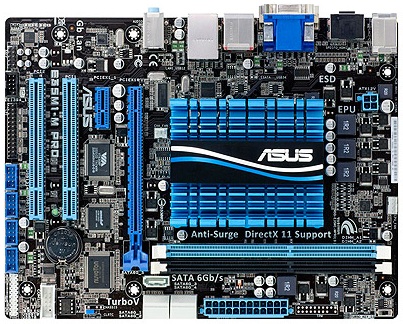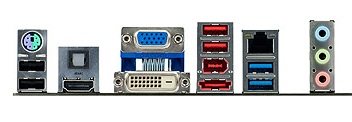ASUS E35M1-M Pro Review - Anyone For Fusion?
by Brendan van Varik on October 25, 2011 5:00 AM EST- Posted in
- Asus
- Motherboards
- Fusion
- E-350
The low powered AMD Fusion market is still an active one, and although the ASUS E35M1-M Pro has been available for a while, we have been asked to have a look. By definition, it is a low powered board with a 1.6 GHz dual core and a 500 MHz GPU clock with 80 stream processors. We clocked a basic system at around 32 W idle, with the APU cooled passively.
Overview
Whilst CPU or GPU intensive tasks are out of the question with a Fusion based system, Fusion boards do have their own advantages such as ultra low power consumption devices, which allow the APU to be passively cooled for a truly silent PC. The optional supplied micro-fan does not add much noise into the equation for low usage, but each end user may or may not want the noise in the background.
There are plenty of connectivity options available on the E35M1-M Pro. In total, there are six SATA 6 Gbps ports and twelve USB 2.0 ports available on this motherboard which should satisfy most requirements. Full HD playback is made possible by the built-in AMD HD 6310 GPU.
Overclocking is possible on the E35M1-M PRO, but as Ian has mentioned before in his round up of three Fusion E-350 motherboards, it is always down to how lucky you get with your silicon because the APU is already installed on the motherboard when you buy it. A respectable overclock of 12% was obtained which brings the final clock speed of the CPU up to 1.792 GHz.
Visual Inspection
The ASUS E35M1-M Pro makes use of a low power APU from AMD which is located under the heatsink in the middle of the board. ASUS are maintaining their current color scheme for their non-ROG branded boards and have gone with blue and black combination. The Hudson M1 FCH is located next to the APU and it provides support for six SATA 6 Gbps ports, five of which are internal and one is an eSATA port. Out of the five internal SATA 6 Gbps ports, four of them are angled and point away from the motherboard and one is not.

On the expansion side of things, we have a PCIe x16 slot which is electronically limited to x4, a PCIe x1 slot and two PCI slots. There are four USB 2.0 headers which will allow for up to eight extra USB 2.0 ports to be added into your system as well as a USB 3.0 header for an additional two USB 3.0 ports.

On the back of the board, we have a PS2 port (that can be used for either a keyboard or a mouse) and a total of four USB 2.0 ports. Two USB 3.0 ports are located under the gigabit LAN. Three different kinds of video connectivity are available and they consist of HDMI, DVI and D-SUB. There is also a S/PDIF optical output as well as a trio of audio jacks.

There are only two fan headers on this motherboard, one of which is for the CPU fan, which is located above the heatsink and just to the left of the DIMM slots. The second one is for a chassis fan and is located near the bottom left-hand side of the heatsink. An extra fan header would have been nice to see on a board this size, though is not absolutely necessary.










66 Comments
View All Comments
C300fans - Tuesday, October 25, 2011 - link
1, If DXVA 2.0 works FLAWLESSLY , it works.2, It is good.
spaceyyeti - Tuesday, October 25, 2011 - link
1. Yes, it can. Even 1080p flash (on windows) is kidsplay for fusion.2. Way better then Intel's. I run linux and I get some glitches, but those are really really rare. Under windows there are no problems at all.
C300fans - Tuesday, October 25, 2011 - link
2, If you use cpu to decode high rate files, it will have obivous glitches.spaceyyeti - Tuesday, October 25, 2011 - link
it's not a cpu problem. the ati linux drivers are not that great lately, so uvd3 support is still a bit problematic. but as I said; the glitches are rare. some movies get none, others get 1 or 2 in an hour. they are not annoying or even that noticeable. and yes, I checked my codecs :-) the main problem with the ati drivers nowadays is bad support for gnome-shell/gnome 3. artifacts al over the place. haha. but that's not really relevant to this article.plonk420 - Wednesday, October 26, 2011 - link
it's not high bitrates that have issues, it's retarded settings that go out of Level 4.1 specs, like 16 reference frames @ 1080p.i just wish this was ~20-30% faster and 1/4th the GPU speed. it's just ever so slightly too slow for Spline scaling in ffdshow, IIRC.
Meegulthwarp - Tuesday, October 25, 2011 - link
Nice to see a power supply that reflects what most people would be using with this setup. It would be interesting to have a comparison between this 250w and a 1000w to see if all the haters were correct.Once again, nice review. Currently looking for a HTPC for my new flat. Just worried AMD might release a refresh of Fusion when I buy one. Anyone know if there is a refresh on the horizon?
spaceyyeti - Tuesday, October 25, 2011 - link
The E-450 is coming. Higher CPU and GPU clockspeeds (cpu: 1,65ghz gpu: 508mhz with 600mhz turbo) and a better memory controller supporting 1333mhz. But you can do that with this board too, by just selecting it in the bios.Other than that, you'll probably have to wait for a process shrink.
http://www.anandtech.com/show/4407/the-brazos-upda...
Meegulthwarp - Tuesday, October 25, 2011 - link
Thanks, I thought I saw that but couldn't find it. Might just mull it over and give the E-350 a pass for the time being.lestr - Tuesday, October 25, 2011 - link
Ancient history folks. Asus has updated to the 450. Boards have been available in Asia and Europe for weeks now. Slight bump to 1.65 and RAM std upped to 1333, OC 1600. No idea how it would test out - hasn't been done yet. Can't understand why they only have 3 analog audio outs on the rear. BIOS tweaks? who knows.I sent an e-mail to Anand 2 weeks go asking him to get Gary to send one over... Oh well.. we'll see who gets it first. Nice try and a good re-introduction.
silverblue - Tuesday, October 25, 2011 - link
I'm very interested to see if the extra memory bandwidth does anything for the HD 6320 or if it runs out of steam, in which case AMD would've been right to only include a single channel memory interface.